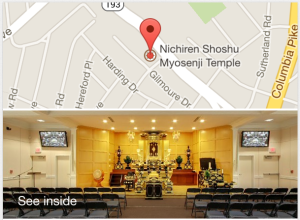
What is Nam Myoho Renge Kyo and Why You Need to Know About It
Myosenji Temple hosts weekly Introductory meetings so our Chief Priest can explain to guests the proper Buddhist chanting of Nam Myoho Renge Kyo and how it creates human happiness. Check our calendar for the next meeting.
In the infinite past, Kuon-ganjo, the True Buddha named the ultimate Law or true entity of life in the universe as Nam-Myoho-Renge-Kyo. In view of the person, the life of the True Buddha, Nichiren Daishonin Himself is “Nam-Myoho-Renge-Kyo.” Literally “Nam” means devotion and “Myoho-Renge-Kyo” is the title of the Lotus Sutra. A simplified translation means “Devotion to the Mystic Law of the Lotus Sutra.”
Nam-Myoho-Renge-Kyo is also called the Mystic Law of cause and effect, because within it is both the cause and effect of attaining Buddhahood. “Renge” means Lotus Flower. The Lotus Flower produces its flower and seeds at the same time, representing the simultaneity of cause and effect. The cause is to chant Nam-Myoho-Renge-Kyo and the effect is attaining enlightenment.
Even though Buddhahood exists within our lives, we are unaware of it until we begin to chant to the Gohonzon. It is important to understand that without fusing with the life of the True Buddha we cannot actualize it in our own lives.
Once we awaken this true entity within our lives we manifest the immeasurable wisdom and power to overcome adversity and reveal our own enlightened life.
Just as the word “India” includes within itself all the mountains, rivers, treasures and people of India, Nam-Myoho-Renge-Kyo includes within itself all of the teachings and benefits of Buddhist practice.
The depth and significance of chanting Daimoku (Nam-Myoho-Renge-Kyo) cannot be fully explained but has to be experienced through practice to grasp the meaning and benefits within your own life.
Reference: An Introduction to True Buddhism, Answers to Frequently Asked Questions, pages 2-3, Nichiren Shoshu Temple.


